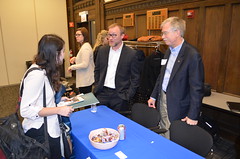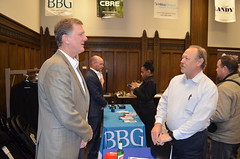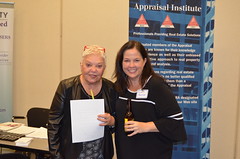Monthly Archives: November 2015
ICAP ATTENDS AQB PUBLIC HEARING
ICAP ATTENDS AQB PUBLIC HEARING
Reported by ICAP Director, Karen Emerle, SRA
The Appraisal Qualification Board (AQB) held a public hearing October 16, 2015 in Washington, D.C. This hearing was to facilitate comments on their “Concept Paper – Alternative Track to the Experience Requirements in the Real Property Appraiser Qualification Criteria” issued on July 9, 2015.
AQB Concept Paper Alternate Experience
Four groups of panelists testified before the AQB. They were the Appraisal Practitioners Panel, State Appraiser Regulatory Agency Panel, Users of Appraisal Services Panel, and Educators Panel. There was a brief question and answer period at the end of each panel’s presentation. Public comments were to be allowed at the end of the hearing.
Appraisal Practitioners Panel members were Dennis Badger representing Farm Credit Mid-America (FCMA), William Fall representing the William Fall Group (a member of NAC), Jordan Petkovski representing the National Appraisal Congress (NAC), and Scott Schafer representing Cushman & Wakefield.
Dennis Badger testified only to a limited degree can altering the requirements address any lack of certified appraisers. Anticipated earnings is one of the main factors in an individual deciding on a vocation. The anticipated longer term rewards may not be sufficient to attract people to the profession. Utilization of alternative paths to experience could be granted to a limited degree. Other tasks such as data collection and analysis without a subject property or appraisal assignment could be considered in the same way experience gained for work without a traditional client is currently permitted. Experience in parallel professions should be considered with controls established for verification of the relevancy and amount of hours claimed. Additional research into a practicum course is considered prudent. However, there should be a limit to the non-traditional appraisal experience currently in place. Trainees having difficulty in finding a supervisor-trainee relationship may benefit from a minor revision to supervisory appraiser requirements. And that is removing the first sentence from the criteria, which states, “Supervisory Appraisers shall be state-certified and in “good standing” in the jurisdiction in which the Trainee Appraiser practices for a period of at least three (3) years.” The Competency Rule in USPAP already addresses this issue.
William Fall believes a better model would leverage experiential and simulative classroom sessions. This would build proficiency over time. Competency could be affirmed through academic rigor demonstrated through examination along with submission of reports appropriate to the credential level. Mr. Fall presented two options for advancement beyond the entry level apprentice/trainee classification. Both options provide for an expected completion time-frame within 6 to 9 months. Upon completion, the trainee would be classified as a Licensed Appraiser qualified to appraiser non-complex properties less than one million dollars. Advancement to the certified level would be similar to the current criteria but would follow a competency based system. Currently licensed appraisers lacking a college degree should be given an opportunity to advance based on a demonstration of competency.
Jordan Petkovski testified he believes there is a lack of certified appraisers which can be remedied by altering the experience requirement. In certain markets throughout the country difficulties in assigning appraisals are reported. This experience is occurring in markets where previously no difficulty was noticed. Mr. Petkovski believes alternatives for non-appraisal experience can be developed and that this is predominantly a residential classification issue. While practicum courses are a viable alternative, it appears that developing such courses are complex and not economically feasible. NAC is proposing an experience verification matrix be developed and include contact information for current or past employer(s). They also recommend developing a matrix to facilitate clarification of the non-appraisal experience as to qualification for experience and for the audit process. There does not appear to be any basis to support the current experience hours requirement. A senior year college internship would provide better practical experience.
Scott Schafer conducted a survey of Cushman & Wakefield’s managers across the country. The survey addressed topics in the AQBs Concept Paper. Mr. Schafer noted that the managers he surveyed were primarily involved in commercial activities. While the results indicated a recognized prerequisite to become an effective and profitable appraiser is adequate experience requirements, it was thought that the 3,000 hours for state certification may be excessive. Practical appraisal experience should not be compromised and any alternative credit experience should be limited in nature. Significant costs are associated with training and make mentoring un-appealable. There are isolated markets where appraiser shortages exist. Trends in average fees have decreased over the last several years, and no market was identified where fees have recently increased. This suggests appraiser supply in most markets is not a problem. Altering requirements in order to increase appraiser supply could result in unintended consequences prompting experienced appraisers to exit the profession and comprising appraisal quality. Commonly cited issues for appraisers are “low fees resulting in reduced income, scope creep, onerous client review process, requiring designated individuals to perform all inspections and AMC issues.” It is believed there would be a negative impact on the quality of the appraisers in the profession if the experience requirements were “watered down.” Worth consideration is advertising the profession to prospective trainees. This can be accomplished through campaigns at colleges emphasizing competitive compensation, flexible work schedules, and diversity of skills. Mr. Schafer noted additional consideration should be given to “promoting best practices on training techniques and ways to reduce associated costs, develop methods to dissuade trainees from leaving a firm once training is completed until an ample return can be realized by the firm, work with the states to streamline and/or reduce the continuing education requirements, and consider reducing the number of classroom hours required.” Mr. Schafer concluded his testimony calling for more empirical information on appraiser supply and fee trends rather than relying on merely subjective perception before any actions are taken.
To read their written testimonies click Below:
AQB questions:
- How much should be attributable to experience? Are there any practical solutions for developing a practicum course?
- Needless appraisals would be performed for no rewards.
- Is the perceived appraisal shortage more market driven? Is there something that prevents new people form coming into the profession?
- There is a shift in the way trainees are used in the field. A lot has changed over the years.
- Should alterative experience be offered to both segments, commercial and residential?
- No
State Appraiser Regulatory Agency Panel participants were Sherry Bren representing the South Dakota Appraiser Certification Program, Larry Disney representing the Kentucky Real Estate Appraisers Board, Mark Rattermann representing the Indiana Real Estate Appraiser Licensure & Certification Board, and Juana Watkins representing the Florida Division of Real Estate.
Sherry Bren is currently the Chair of AARO’s Appraiser Qualifications Advisory Council. Ms. Bren testified to the impracticability of a “one size fits all” approach. According to the banking industry the rural areas of South Dakota face a shortage of appraisers. South Dakota has a population of 845,000 people, 66 counties, and a little over 77,000 square miles equating to 10 people per square mile and one appraiser per 220 square miles. Sixty-five percent of South Dakota appraisers are 51 years of age or older. There is a vast difference between South Dakota and California, for example. Ms. Bren stated “South Dakota supports the acceptance of parallel profession experience, experience through practicum courses, and reducing the period of time required before upgrading to a higher classification.” Suggestions for eliminating the unnecessary barriers within the Criteria are to eliminate the supervisor appraiser three year requirement, permit exempt appraisers such as an assessor or federal agency staff appraiser to be supervisors, and allow States flexibility in entry-level appraiser credentialing. Ms. Bren also suggested the industry should actively promote non-client experience, allow for periodic experience compliance review prior to the end of training, and abstain from any disciplinary action against the supervisor or trainee as a result of the periodic reviews. To minimize the risk of “training their competition,” a model contract to be utilized by supervisors should be developed. Ms. Bren promotes a practicum course be developed by the Appraisal Foundation “to achieve 50% non-client, non-traditional experience hours for entry-level appraisers.”
Larry Disney believes the key to success is some training. He currently does not see a lack of appraisers, but does believe the future is a concern for the residential appraiser. Offering some wisdom, he quoted Mohammed Ali, who said: “A man who’s viewed the world the same at 50 as he does at 20 has wasted 30 years.” Mr. Disney felt it is essential to recognize alternative experience in related fields, and mentioned Real Estate Brokers/Agents, Tax Assessors, Right-of-Way, Agriculture & Forestry Appraisers, Land and Soil, Real Estate developers and builders, attorneys, and lending professionals as examples. Currently, experience hours logged are only for completed appraisal assignments. Mr. Disney suggests experience hours should be recognized and hours allowed to be logged for work performed in sales analysis, market analysis, income studies, demonstration reports, and appraisal specific studies. He recommended an update and restructure to the experience log that would be all inclusive and which would also recognize education papers deemed creditable through the process of qualified review as experience. An idea he presented would be to explore why the time to obtain experience has to be 24 or 36 months; can it be done in 6 months or a year? And, to further that exploration, research other professional licensing programs for alternative solutions. Mr. Disney recommended the “trainee” credential be eliminated and replaced with an entry level license credential which would allow the individual to immediately begin appraising while working within an established appraisal office.
Mark Rattermann does not believe the college degree requirement should be changed. He felt it made a huge difference in the quality of candidates entering the field. In relation to the shortage of appraisers, his data indicated in metropolitan areas there may be an oversupply of appraisers with a lack in the more rural areas. Significant obstacles for attracting new people into the profession include the “low earnings potential, a lack of benefits, a lack of opportunities to associate with a required supervisor, and fear the industry is in decline.” Retention of existing appraisers is hampered by “low income levels, imposition of unnecessary requirements, excessive follow up work on each assignment, significant expense of continuing education, and increased liability.” Mr. Rattermann believes any use of alternative experience should only be done if it can be truly verifiable experience and thinks the experience requirements should remain as they are currently. He recommends eliminating the word “trainee” from the license title as he believes it is demeaning and clients do not accept the trainee to work on their assignments.
Juana Watkins presented Florida’s statistical information relative to their State registered appraisers. Currently in Florida there are 6,388 active certified and residential appraisers. Currently the number of trainee appraisers is 474 which equates to a 13 to 1 ratio. However, of the 474 trainee appraisers, 176 are in a current, inactive status as these trainees do not have a registered supervisor which prevents them from obtaining any experience. The number of involuntary, inactive status trainees in Florida is 438. These are trainees who have not stayed current with the requirements to renew their licenses. Florida had 951 trainees in this inactive, involuntary category prior to their November 2014 renewal. Rather than reactivate their licenses, nearly half of those 951 trainees left the industry. In reality, due to Florida law and the Criteria not all of the 6,388 certified appraisers are qualified to supervise a trainee. Ms. Watkins views the idea of practicum courses as a sophisticated way of saying internship, the financial costs may be prohibitive, and an unintended consequence of which may tend to stigmatize the trainee classification even further. Ms. Watkins questioned whether the time delay imposed to obtain sufficient number of experience hours is really a benefit to the profession. Considering there are 2,000 work hours in a given year, based on a 40-hour work week and 50 work weeks, does the current criteria present a barrier to those trainee appraisers who accumulate 2500 hours in less than 24 months? Ms Watkins expressed her concern related to allowing non-appraisal experience performed by licensees of related professions. It must be verifiable and relevant. It should be a small percentage of the required experience. For example, how would one review an alternative work product produced by an economist to determine its equivalency to USPAP?
AQB questions raised and panel answers are as follow:
- Can a degree program be done?
- If we can show less deferment and more inclusiveness. What would be the certified appraisers’ role? Will the States have the ability to have an internship? It takes approximately 1.5 years to change a rule. How much would it be for the States to measure alternative experience?
- How would the State match up a trainee with a willing supervisor?
- Must match the exam with the experience. If one is new in the field, must have a college degree. If already have a license and trying to move up, a degree should not be required.
- Should it be a strict rule or should the rule provide great flexibility?
- Great flexibility, as one size does not fit all. The States can competently address any issues if allowed great flexibility. Mr. Rattermann commented Indiana, without having flexibility, will not go beyond the minimal requirements.
To read their written testimonies click Below:
Appraisal Services Panel participants were Steve Apodaca, representing the American Bankers Association (ABA), Rick Langdon, representing Wells Fargo, Joan Trice representing Allterra Group, LLC, and John W Ross. While Mr. Ross is employed by the U.S. Department of the Interior, his comments are solely his own and do not represent either a formal or informal position of the Department of Labor.
Steve Apodaca’s testimony touched on a number of issues. There is a difference between large banks participating nationally, and the regional and small community banks. There is a belief that certain market segments are experiencing a shortage of appraisers. These markets tend to be rural areas. It is felt that the residential appraisal has been commoditized, the average appraisal fees are dictated by a third party that provides no value in the appraisal function, and this results in appraisers not being able to earn a decent living. In turn, this creates an environment whereby appraiser’s work product mentality becomes “shortest time, least work, good enough,” in order to increase volume and make up for the stagnating fees. Furthermore, the current supervisor-trainee model is not sufficiently functioning, state-to-state the application of rules, regulations, and educational requirements is inconsistent, and experience levels of parallel professionals are not considered in the educational requirements. Mr. Apodaca stated the experience requirement issues should address all appraisal classifications, and advocates for shorter time frames in which to gain the experience. He suggested the credentialing system be gradually changed. The road to credentialing would begin with the educational courses. There would be no time frame for completing the courses. Completion of the courses would lead to a comprehensive exam. Passing would provide the Certified General or Residential credential, and then be subject to a 12 month probationary period as an appraiser. Their work product would need to be submitted to the state to be able to renew their license for the next year. College degrees specifically in real estate or finance are required with an alternative track provided for those with related experience but no college degree. It is believed competency can be established through both experience, practicum, and/or degree. Simplification of the licensing process is needed, they would prefer only two classifications, residential and general, and designations from accredited organizations allow for further specialization.
Rick Langdon is the Chief Residential Appraiser for Wells Fargo. Three years ago, Wells established its own appraisal training program. They had 1500 responses to the 10 appraisal trainee positions posted. The trainees hired have been in 4 months now. Applicants indicated little to no job awareness, an online course was preferred over in- person training, there are limited outlets to establish field experience, compared to other alternatives available to the candidate the pay incentive is low, and based on what this profession requires the available field instruction/training is sub-par. Mr. Langdon offered several suggestions. Allow a small percentage of experience training in parallel professions. Allow a percentage of the required hours to be a practicum course. Implementing the parallel profession training and practicum course would allow the actual field experience required be lowered. While supporting a 4-year degree, he suggests a sufficient alternate would be a focused 2-year degree. This would attract new appraisers. For the certified residential license the degree would be focused in Real Estate, Real Estate Finance, Finance, or Real Estate Development. The solution for obtaining field experience is limited as there is not an established college internship program, generally there is a loss of time and income for either someone established in a career switching over to the appraisal profession and/or for the established appraiser providing the trainee supervision, and independent appraisers are training their replacements.
Joan Trice stated that appraisal quality is a growing concern and appraisers played a role in the housing finance crisis. The Collateral Risk Network (CRN) annual survey results indicate chief appraisers in both the lending community and the appraisal management companies (AMCs) view appraisal quality as their single biggest concern.
When lenders report appraiser shortage they are referring to extended turn times. Is there a shortage of appraisers?
Ms. Trice suggests there is not a shortage of appraisers but a lack of appraisers willing to accept the low fees, increasing pressure for faster and faster delivery times while simultaneously demanding more data, photos, and analysis content. Ms. Trice believes the “standards are too high, earnings are too low, future is uncertain, and the current population may not be equipped to train the future generation.” She suggests eliminating the trainee and supervisory requirements, establish a peer review process, and provide better education. The opportunity to develop new courses should not be restricted. The voluntary Course Approval Program (CAP) process is burdensome and only half the States participate. Ms. Trice invites “the Appraisal Foundation (TAF) to consider exiting the education business they recently entered with the Alliance for Valuation Education (AVE). Having TAF compete with education providers and trade associations removes the competitive market forces from investing in new material. This is the exact opposite of what should be achieved to reinforce the public trust.”
John Ross noted while he is employed by the U.S. Department of the Interior, his comments are solely his own and do not represent either a formal or informal position of the Department. The Department requires a general appraiser with unique skill-sets and experience to appraise complex natural resource properties. The Department has committed to a formal Apprentice Program; it is a costly and laborious process. Mr. Ross suggested non-traditional experience be considered. However, he believes there is “no substitution for actually undertaking the appraisal process” and any alternative experience be limited to the overall experience requirement. Due to the wide variety of property types and markets, Mr. Ross does not believe the use of a practicum course is practical for non-residential experience. For non-residential appraisers, reduction in experience hour requirements might be met through time spent in an alternative profession and successful completion of education at a threshold level. However, there should a requirement set for a minimum number of hours actually spent directly in the appraisal process. Mr. Ross proposed a tiered profession requiring different levels of education or experience with incentives for those wishing to achieve higher licensure levels. Perhaps, as Mr. Ross suggests, the entire profession along with the entire process of qualifying appraisers should been seen through a wider lens.
AQB posed the question:
Q There is reluctance for appraisers to supervise a trainee because of future competition? Is this true?
- Yes. And we don’t have a solution.
- Eliminate the current model, and move to a more peer review model.
- “Trainee” status is the “kiss of death.” Lenders will not accept the “trainee” status.
- We have lost appraisal firms, we have lost a lot. Some of this is due to AMCs.
To read their written testimonies, click below:
Educators Panel participants included Dan Bradley representing McKissock, David Harper representing the International Association of Assessing Officers (IAAO), and Steve Thode representing Lehigh University.
Dan Bradley testified that basic economics is the driving force behind the struggle to attract people to the profession and get practicing professionals to become mentors. Appraisers do not make enough money and do not perceive any economic benefit from a supervisor-trainee relationship. It has to be economically attractive and it isn’t. Mr. Bradley concludes there may be a need to either shorten the minimum period for obtaining experience or allow alternative experience credit. Mr. Bradley comments addressed practicum courses, non-appraisal experience in parallel professions, shortening the experience time frame, and allowing post-credentialing appraisal experience. The cost would be prohibitive, by necessity the course would need to be regional in nature, and require a significant time commitment on the course provider and instructor. Parallel profession experience should be limited to 20% of the total experience, should be verifiable, and should be in a profession with similar barriers to entry and documentation requirements. Mr. Bradley recommends shortening the time periods by six months for both the residential and general credential experience hours criteria. Mr. Bradley holds the opinion that there should not be a shift in the credentialing system as it would have a negative impact on public trust.
David Harper proposes uniform recognition of mass appraisal experience and education by both the AQB and member States. He asserts” work performed by assessors and appraisers specializing in mass appraisal techniques to perform appraisals for ad valorem property tax appraisals does not represent non-appraisal experience.” He believes cross training in mass appraisal and single property techniques would be a benefit to the profession. Currently, 7 States do not accept mass appraisal experience, 15 States accept mass appraisals to meet 100% of the requirements, 3 States accept mass appraisal experience if it is in compliance with USPAP Standard 1 and 2; 13 States accept mass appraisal with limitations on the percent to total hours required, and 12 States accept mass appraisal hour experience gained as a registered trainee or licensed appraiser. Clarification from the AQB is needed regarding acceptance of mass appraisal. The AQB could provide a dedicated mass appraisal experience log. Does a governing body qualify as a traditional client under USPAP? Mr. Harper believes the designations issued by IAAO qualify the designees to sit for state certification exams and receive the related licensing or certification credentials.
Steve Thode is the Director of the Goodman Center for Real Estate Studies at Lehigh University. Their ire@//Program integrates appraisal and valuation issues and techniques. College graduates find the barriers to entry, the short term or long term compensation, and legal liability as compared to other careers to be a deterrent. Mr. Thode suggests students have a mentor prior to completing their requirements and allow the candidate to start gaining experience hours while under the mentor-ship. He believes a leadership role in encouraging more interest in the appraisal profession and in mentoring promising candidates should under-taken by the various appraisal organizations.
To read their written testimonies, click below:
AQB Questions:
- What is the viability of a practicum education course designed by the AQB covering a semester or two offering 750 or may be a total of 1500 hours?
A: Come closer today with modern technology.
- How many hours?
- Student responses were either “it was way too much work” or “I would do it again in a heartbeat.” The hours don’t really add up to much; ten hours a week for 30 weeks or about 300 hours. Combined with an internship, could get 1500 hours over a 3 or 4 year period.
- If the Board would take on the project of a practicum course, who would write it? Would McKissock or the University get involved in on-line courses the AQB puts out with the means to get it developed?
The AQB received 100 written comments. Unfortunately, there was not enough time remaining to entertain public comments.
Important Information From The IDFPR
Important Information From The IDFPR
The Illinois Department of Financial and Professional Regulation (IDFPR) will be using email as the primary notification method for license renewal notifications and other important notifications.
The IDFPR requests that ICAP members update their phone number, email address, and/or address following the instructions below:
- Click here to update your profile
- Select your license level
- Make sure that ‘Change/Verify Address & Contact Info’ is selected in the ‘reprint reason’ dropdown box.
- Enter your licensee number, US social security number, and date of birth.
- Click ‘Search.’
- Once your information has been found, it will be displayed and updates can be made to phone number, email, and address fields.
- Make the desired updates and click ‘Save’ to lock them in the system.













